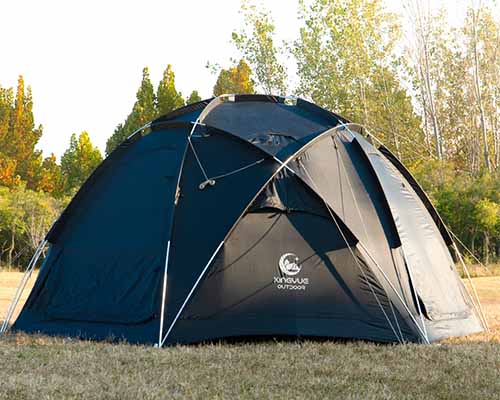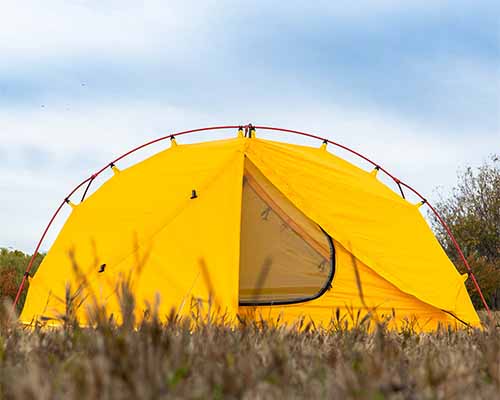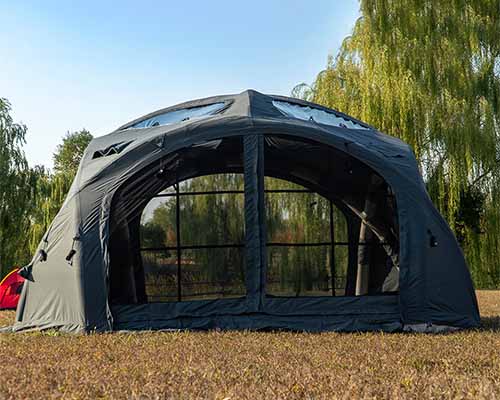Table of Contents
Introduction

Going deep into the outdoors provides unparalleled opportunities for exploration and getting close to nature. However, with the beauty comes risk, and safety is the top priority for every explorer. A safe outdoor experience is inseparable from a reliable shelter. Compared with traditional tents, camping dome tents provide higher protection in changing environments with their sturdy structure and unique design.
This article will introduce how camping dome tents can significantly improve outdoor safety through structural advantages, material upgrades and practical functions. As a tent manufacturer focusing on safety and reliability, Xingyue provides a variety of tents, including inflatable tents, ultra-light mountaineering tents, tunnel tents, hotel tents and high-strength aluminum pole tents to meet different adventure needs.
The Engineering of Safety: Why Dome Tents Stand Out
The fundamental design of a camping dome tent is inherently geared towards stability and resilience. Unlike ridge or cabin tents, which often rely on fewer intersecting poles, the dome tent’s structure consists of a series of flexible poles that arch over the tent to form a self-supporting, rounded shape. This geodesic-inspired architecture is not merely aesthetic; it’s a powerful engineering solution for resisting external forces.
The intersecting arches distribute stress evenly across the entire structure, making a camping dome tent exceptionally stable against high winds and heavy snow loads. This inherent stability minimizes the risk of collapse, which is a significant safety concern in unpredictable outdoor conditions. The rounded shape also reduces the surface area exposed to direct wind, allowing gusts to flow over and around the tent rather than pushing against flat surfaces that could act as sails.
Structural Stability in Adverse Conditions
One of the primary ways a camping dome tent improves safety is through its superior structural integrity, particularly when facing challenging weather. In high winds, the continuous curve of the dome design prevents any single point from bearing the brunt of the force. Instead, the pressure is dissipated across the entire framework, significantly reducing the likelihood of poles bending or breaking. This is a critical factor for campers caught in unexpected storms, where tent failure can quickly escalate a minor inconvenience into a dangerous situation.
Similarly, in snowy conditions, the sloped walls of a camping dome tent prevent snow from accumulating heavily on the roof, naturally shedding it to the ground. This minimizes the risk of structural overload and collapse, which is a common hazard for tents with flatter roofs. Reliable tent manufacturers pay close attention to the load-bearing capabilities of their dome designs, ensuring they can withstand significant pressure from precipitation, adding another layer of safety for cold-weather campers.
Essential Safety Features of a Modern Camping Dome Tent
Beyond its fundamental shape, modern camping dome tent designs incorporate specific features that further enhance user safety. These features are the result of continuous innovation by tent manufacturers aiming to provide optimal protection.
Material Durability and Weather Protection
The materials used in a camping dome tent are fundamental to its protective capabilities. High-quality fabrics are chosen for their resilience against various environmental threats. Waterproofing is achieved through durable coatings and taped seams, preventing water ingress during heavy rainstorms, which is vital for preventing hypothermia and protecting gear. UV resistance treatments prevent fabric degradation from prolonged sun exposure, extending the tent’s lifespan and maintaining its structural integrity over time. Furthermore, ripstop technology, woven into many tent fabrics, prevents small tears from expanding, containing damage and maintaining the tent’s shelter capabilities even if punctured.
The ground tarp and floor material are also crucial. A robust, waterproof floor prevents ground moisture from seeping in, keeping the interior dry and warm. This is especially important for preventing discomfort and health risks associated with dampness during extended stays.
Here’s a look at common material features that enhance the safety and longevity of a camping dome tent:
| Feature Type | Material/Design Consideration | Safety Benefit |
| Waterproofing | High Denier Polyester/Nylon, PU Coating, Taped Seams | Prevents water ingress, reduces hypothermia risk, keeps gear dry |
| UV Resistance | Treated Fabrics | Prevents fabric degradation from sun, maintains structural integrity over time |
| Tear Resistance | Ripstop Weave | Contains small tears, prevents catastrophic fabric failure, extends lifespan |
| Floor Material | Heavy-duty Polyethylene or Coated Nylon | Prevents ground moisture entry, creates dry living space, improves insulation |
| Ventilation | Mesh Panels, Vents with Rainfly Coverage | Reduces condensation, prevents CO2 buildup, ensures fresh air |
| Fire Retardancy | FR-Treated Fabrics (to standards like CPAI-84) | Slows spread of flames, provides critical escape time in emergencies |
Ventilation and Air Quality
Proper ventilation is a key safety feature often overlooked. A well-designed camping dome tent incorporates multiple vents and mesh panels, strategically placed to allow for continuous airflow. This airflow is vital for several reasons: it minimizes condensation buildup inside the tent, preventing dampness and discomfort. More importantly, it ensures adequate oxygen supply and prevents the dangerous accumulation of carbon dioxide, especially when occupants are sleeping or if any fuel-burning appliances are inadvertently used nearby. Good ventilation is a non-negotiable safety feature, and reputable tent manufacturers prioritize its integration into their designs.
Beyond Design: User-Centric Safety Considerations
While the physical attributes of a camping dome tent are paramount, their contribution to safety also extends to how users interact with them in real-world scenarios.
Ease of Setup and Emergency Preparedness
The relatively straightforward pitching process of a camping dome tent is a significant safety advantage. In rapidly deteriorating weather conditions or unexpected emergencies, the ability to quickly erect a stable shelter can be life-saving. Complex tents that require extensive time and effort to pitch can leave campers exposed to the elements for longer than desired. A camping dome tent allows for swift deployment, minimizing exposure to rain, wind, or cold, and providing immediate refuge when circumstances demand it. This ease of use also means less frustration, which contributes to clearer thinking in a stressful situation.
Furthermore, easy access and egress are vital. Multiple large doors, particularly in larger dome tents, ensure that occupants can exit quickly in an emergency, reducing the risk of being trapped. Features like glow-in-the-dark zipper pulls can also aid in rapid exits during the night.
Visibility and Reflective Elements
Safety in the outdoors isn’t just about internal protection; it’s also about being seen. Many high-quality camping dome tent models incorporate reflective guylines and external loops. These elements dramatically increase the tent’s visibility in low-light conditions, preventing accidental trips over guylines at night and making the tent easier to locate by search and rescue teams if an emergency arises. For tent manufacturers, integrating these simple yet effective features demonstrates a comprehensive understanding of outdoor safety.
Choosing the Right Camping Dome Tent for Your Adventures


Selecting the ideal camping dome tent involves considering several factors related to your specific needs and the environments you’ll encounter. Always prioritize tents from reputable tent manufacturers who adhere to high safety standards. Look for certifications and clear specifications regarding water resistance, UV protection, and material composition.
Consider the tent’s season rating (3-season, 4-season) based on your intended use. A 4-season camping dome tent will have stronger poles, heavier fabrics, and better wind resistance suitable for extreme conditions. Evaluate the ventilation system, ensuring it’s adequate for your climate. Finally, check reviews and professional assessments to gauge real-world performance and reliability, ensuring the tent lives up to its safety claims. Investing in a quality camping dome tent is an investment in your safety and comfort.
Conclusion
Camping dome tents take safety to new heights with stable structures and smart designs. Their inherent stability against the elements, combined with advances in material science and user-centric features, provide campers with a safe and reliable haven. From effectively dispersing wind loads to preventing condensation buildup, every aspect of a well-designed camping dome tent contributes to a safer and more enjoyable outdoor experience.
As a professional manufacturer in the tent industry, Xingyue always puts safety at the core. Whether it’s a lightweight mountaineering tent or a large hotel tent, we adhere to high quality standards to protect your every adventure. Welcome to contact us to learn how to improve outdoor safety with our tents.
FAQ
Can a camping dome tent withstand strong winds and heavy snow?
Yes, high-quality camping dome tent designs are excellent for strong winds and moderate to heavy snow. Their geodesic or modified dome shapes distribute stress effectively, preventing collapse. However, always check the tent’s specific season rating and wind/snow load recommendations from the manufacturer.
How does ventilation in a camping dome tent improve safety?
Proper ventilation is crucial for safety by preventing condensation, which can lead to dampness and hypothermia, and by ensuring adequate airflow to prevent the buildup of carbon dioxide, especially in enclosed spaces or when using certain heating devices safely.
Are there specific safety features to look for in a family-sized camping dome tent?
For family-sized camping dome tent models, prioritize multiple large doors for easy entry/exit, good ventilation, durable ripstop fabrics, and clear instructions for setup. Some models may include internal pockets for organized storage, reducing trip hazards.
